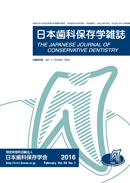Volume 59, Issue 1
Displaying 1-15 of 15 articles from this issue
- |<
- <
- 1
- >
- >|
Original Articles
-
2016 Volume 59 Issue 1 Pages 1-8
Published: 2016
Released on J-STAGE: February 29, 2016
Download PDF (397K) -
2016 Volume 59 Issue 1 Pages 9-21
Published: 2016
Released on J-STAGE: February 29, 2016
Download PDF (1282K) -
2016 Volume 59 Issue 1 Pages 22-31
Published: 2016
Released on J-STAGE: February 29, 2016
Download PDF (1137K) -
2016 Volume 59 Issue 1 Pages 32-39
Published: 2016
Released on J-STAGE: February 29, 2016
Download PDF (1488K) -
2016 Volume 59 Issue 1 Pages 40-46
Published: 2016
Released on J-STAGE: February 29, 2016
Download PDF (533K) -
2016 Volume 59 Issue 1 Pages 47-57
Published: 2016
Released on J-STAGE: February 29, 2016
Download PDF (2113K) -
2016 Volume 59 Issue 1 Pages 58-64
Published: 2016
Released on J-STAGE: February 29, 2016
Download PDF (2221K) -
2016 Volume 59 Issue 1 Pages 65-73
Published: 2016
Released on J-STAGE: February 29, 2016
Download PDF (3395K) -
2016 Volume 59 Issue 1 Pages 74-84
Published: 2016
Released on J-STAGE: February 29, 2016
Download PDF (3563K) -
2016 Volume 59 Issue 1 Pages 85-92
Published: 2016
Released on J-STAGE: February 29, 2016
Download PDF (855K) -
2016 Volume 59 Issue 1 Pages 93-102
Published: 2016
Released on J-STAGE: February 29, 2016
Download PDF (778K) -
2016 Volume 59 Issue 1 Pages 103-110
Published: 2016
Released on J-STAGE: February 29, 2016
Download PDF (2123K) -
2016 Volume 59 Issue 1 Pages 111-118
Published: 2016
Released on J-STAGE: February 29, 2016
Download PDF (454K) -
2016 Volume 59 Issue 1 Pages 119-123
Published: 2016
Released on J-STAGE: February 29, 2016
Download PDF (2996K)
Case Report
-
2016 Volume 59 Issue 1 Pages 124-131
Published: 2016
Released on J-STAGE: February 29, 2016
Download PDF (1663K)
- |<
- <
- 1
- >
- >|
